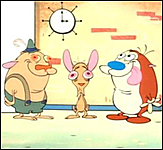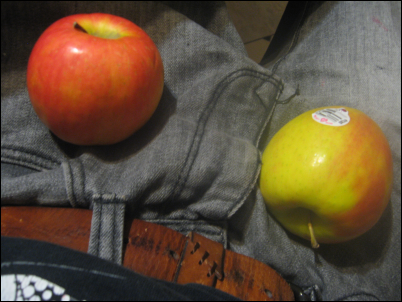I have inspired such creative gestures. |
|
Results 101 to 111 of 111
Thread: I fail to see how this is art
-
04-17-2011 07:16 AM #101
-
04-17-2011 06:39 PM #102Banned

- Join Date
- Jan 2004
- Gender

- Location
- nope
- Posts
- 1,807
- Likes
- 599
-
04-18-2011 12:44 AM #103Banned


- Join Date
- Feb 2011
- LD Count
- 5
- Gender

- Location
- Madison, WI...... Reputation: 10,000,000
- Posts
- 151
- Likes
- 36
- DJ Entries
- 9
Nerve, I have to say that you do in fact have an outstanding taste in apples. The photograph is like a statement about expression itself and how the nuances of everyday conversation coalesce into a complex system of non-deterministic outcomes that can only be fully described through this brilliant maxim: "Art."
-
04-18-2011 03:52 AM #104Banned

- Join Date
- Jan 2004
- Gender

- Location
- nope
- Posts
- 1,807
- Likes
- 599
That's what they call me in irc. Art.
-
04-18-2011 04:06 AM #105Drivel's Advocate



- Join Date
- May 2007
- LD Count
- WhoIsJohnGalt?
- Gender

- Location
- Denver, CO Catchphrase: BullCockie!
- Posts
- 5,589
- Likes
- 930
- DJ Entries
- 9
I fail to see how you are Art.
Art
The ability to happily respond to any adversity is the divine.
Dream Journal Shaman Apprentice Chronicles
-
04-18-2011 07:46 AM #106Banned


- Join Date
- Feb 2011
- LD Count
- 5
- Gender

- Location
- Madison, WI...... Reputation: 10,000,000
- Posts
- 151
- Likes
- 36
- DJ Entries
- 9
That's what I have been thinking of for this entire conversation. From the second I saw your first post in this thread I was grinning to myself: "hehehe... people call him Art"
Completely off-topic here but:
Is it strange that online nicknames have come to the same degree of identity for me as my actual name? Like, saying my own name feels weird. Calling other people with my name by our same name feels... weird. Some of my many online nicknames, as strange as they may be, have approached this same level of identity for me. Like, if somebody were to shout "VERT!" I would automatically turn my head.
-
04-18-2011 09:28 AM #107
-
04-18-2011 01:37 PM #108
bunch of nerds

Ignorant bliss is an oxymoron; but so is miserable truth.
-
04-19-2011 10:36 PM #109Banned

- Join Date
- Jan 2004
- Gender

- Location
- nope
- Posts
- 1,807
- Likes
- 599
I've been Artelis online for about 8 years. I'm pretty locked into it.
I. Am. Art. Ultimate nerd.
-
04-24-2011 05:01 AM #110Banned


- Join Date
- Nov 2009
- LD Count
- LOL I UNNO
- Gender

- Location
- Wherever major appliances are sold!
- Posts
- 1,538
- Likes
- 522
- DJ Entries
- 3
-
05-03-2011 10:41 AM #111Your friendly naga Achievements:









- Join Date
- May 2007
- Gender

- Location
- The funny farm, Chalfont...
- Posts
- 723
- Likes
- 59
- DJ Entries
- 9
Whoa I totally forgot about this thread but let's come back to the answer
One, I had seen some of the artist's other works, and he could paint realism quite okay. And as he was Russian and in 1919 I didn't get the impression that he was being lazy. It would simply be the wrong time and place to have an art market that could bear that kind of exploitation.
Two, it was (and is) pleasing to me in the way Steve Reich might be. The boundaries are very simple, whether visual or harmonic, but by imposing these inordinately silly boundaries other things are suddenly brought to the fore which might be hard to emphasise in regular artmusic. In the case of this square it was not actually about the square but about the grey on the canvas surrounding it which had been painted far less delicately, with cracks in the oil and brushstrokes visible. It was the contrast against the inhuman perfection of the square.
In the world of computers, mathematically perfect squares and forms are the norm; but in 1919 such things would've not been. The boundary between the black and the grey was a rubicon crossed, a line between our forever imperfect world and Plato's world of forms.
Three, I actually saw the painting. YOU CANNOT JUDGE THESE THINGS IF YOU HAVE NOT SEEN THEM IN PERSON. I repeat. YOU CANNOT JUDGE THESE THINGS IF YOU HAVE NOT SEEN THEM IN PERSON. I'm not sure if the red square everybody is talking about here is Rothko (might be) but he had a similar aesthetic, simple squares and contrasts. But two very important related things about his work do not translate onto computers.
1. They're huge things apparently, ten feet long. There's a physical impact you will not get from a computer screen.
2. In the reduction from this size, all the detail of form will be lost in a crappy tiny .jpeg.
Such things as these are integral to the experience of art. You, audiophile, would not say that an mp3 would lend the same understanding as seeing the band live; so how can a picture in a book be the same as the painting?
So, TL;DR: If you go to an art gallery with a minimalist exhibition and an open mind, give the actual paintings rather than pictures of them a good hard look, and think about it a bit - and still think it's talentless shit - then your opinion is well defined and fair, and I will not try to convince you any further.Last edited by Lseadragon; 05-03-2011 at 10:46 AM.
 Originally Posted by Taosaur
Originally Posted by Taosaur
Similar Threads
-
Fail, much?
By Mancon in forum Senseless BanterReplies: 4Last Post: 04-17-2010, 04:04 AM -
WHY, why must i be so fail?
By sheogorath in forum Lucid ExperiencesReplies: 6Last Post: 10-08-2009, 01:39 PM -
Fail fail, fail
By Bing in forum Introduction ZoneReplies: 4Last Post: 12-16-2008, 07:26 AM -
Fail
By asher in forum Senseless BanterReplies: 50Last Post: 04-02-2008, 02:51 AM -
why do RC sometimes fail
By lagunagirl in forum General Lucid DiscussionReplies: 14Last Post: 03-18-2008, 03:26 AM




 45Likes
45Likes LinkBack URL
LinkBack URL About LinkBacks
About LinkBacks






 Reply With Quote
Reply With Quote

Bookmarks